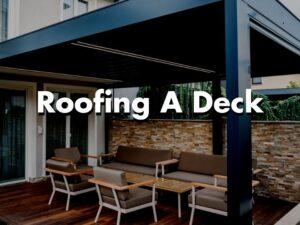Brisbane Deck Builders Does A Comparison Of Decking
Which is superior: a Timber decking vs composite decking?
When designing your dream deck, one of the most critical decisions you will face is which decking boards to use.
The two most frequently used materials are wood (timber) and wood-plastic composites.
This article will discuss the factors to consider when deciding between timber and composite decking, regardless of whether you want to do the work yourself or hire a contractor.
Composite decking vs. timber decking
Wooden decking boards are sturdy and traditional, making them an excellent choice. There is a diverse range of rich, vibrant wood species available. While natural wood has an appealing appearance, each species of wood has its own set of problems. Whichever wood you select, it will eventually deteriorate.
That is why an increasing number of people are opting for wood-plastic composite decking made of recycled wood powder and high-density polythene. Composite decking boards replicate the look of real wood while significantly extending the life of the entire deck.
Finally, you are the one who will select the material for the deck's surface.
The Advantages and Disadvantages of Wood vs. Composite Decking
Both have their own set of advantages and disadvantages, and you must determine which is the better option for you based on your budget, specifications, and overall preferences. If you're unsure of the distinction between composite and wood decking, there are a few points to consider when choosing the perfect material for your dream deck.
Physical appearance – Distinction in appearance and feel.
One of the most common concerns when selecting a decking material is that composites will look inferior to wood. Recent advancements in the manufacturing of composites have enabled them to approximate the natural beauty of wood. Thus, while composite decking boards initially appeared to be manufactured, they have advanced to the point where they can replicate the grain of natural wood, making them more resembling natural wood.
Upkeep And Maintenance
Consider the maintenance and upkeep requirements of each material when comparing a composite deck to a timber deck.
A deck is an investment, and as the focus point of your yard, you want to maximise its lifespan.
Along with routine maintenance, timber decking requires the following upkeep.
Sanding: Sanding is required every two to five years. Sand your deck after pressure washing it, before staining and sealing it, and regularly removing any raised fibres or materials that could cause splinters.
It requires sealing every two to five years. Sealing a wood deck is necessary to protect it from environmental elements such as heat and rain
Staining: This procedure is required every two to five years. Staining protects the deck by waterproofing it and shielding the colour and wood from warping and damage caused by weather and other environmental factors.
It is necessary to repaint every two to five years. Repainting your deck is necessary to maintain its appearance and protect the paint from wear and tear.
Cleaning: Every six months is recommended. Sweeping and cleaning your deck with care.
Although you should clean and inspect your composite deck on a regular basis, this low-maintenance alternative to wood is a hassle-free way to build a beautiful deck. Unlike timber, composite decking boards do not require as much costly and time-consuming maintenance to keep the structure of your deck stable and its appearance beautiful for years to come.
Humidity In Brisbane
A significant disadvantage of timber decking is that the boards readily absorb water and being in Brisbane this can be a problem.
Wood decking boards that are not stained, sealed, or painted on a regular basis are prone to warping, splintering, cracking, and rotting. In comparison, composite decking boards are completely resistant to moisture, allowing them to be installed in areas with high humidity without rotting.
Durability Of The Boards
When selecting a material for your deck, consider its lifespan and the material's ability to withstand general wear and tear as well as harsh weather conditions. While wood decks look fantastic, they can warp, develop dangerous, unsightly splinters, rot, and erode over time due to weathering.
Additionally, the following factors can shorten the life of wood decking: scratching, chipping, stains, and fading/UV resistance.
Composite decking boards, on the other hand, are less prone to these environmental issues. Composite decking can last up to 20 years with proper care, whereas a timber deck has a life expectancy of between 10 and 15 years.
Temperature Of The Deck Surface
One advantage of wood decking is that it is significantly more resistant to heat than composite decking.
While composites can become quite warm when exposed to direct sunlight, wood remains relatively cool.
However, new manufacturing and technology advancements have enabled composite decking boards to reduce their heat absorption and improve their UV stability. If you live in an area with high summer temperatures like Brisbane, this is a critical factor to consider.
The Cost
There is a cost distinction between wood and composite decking. Composite decking boards range in price from approximately $22 to $165 per square foot, including installation. At $80 to AUD 90 per square metre, wood decking boards are just below that. While wood decking boards are less expensive to purchase, the cost of maintenance quickly adds up.
The average cost of staining a deck is AUD 35 per square metre. While composite decking is more expensive initially, you will save money over time by avoiding costly repairs and the time and expense associated with maintaining a wood deck.
Eco-friendly Option
There is conflicting information regarding whether composite or wood decking is more environmentally friendly.
Wood is a biodegradable material.
Natural wood is sourced in Australia from plantations or newly growing forests. Carbon dioxide is naturally absorbed by trees from the atmosphere and stored in their wood.
Even after the wood is harvested and processed into wood products such as decking boards, the CO2 is sequestered in the wood. As a result, the manufacturing process (harvesting, milling, and transport) is more energy efficient than the manufacturing of composite wood.
Composite decking is made up of recycled plastics and wood fibres (such as sawdust). For two reasons, manufacturers of composite decking assert that their product is more environmentally friendly than wood.
1. As the demand for new wood decreases, less wood must be harvested.
2. 95 percent of composite products are made from recycled wood and plastic.
Resistance To Pests
Unlike the majority of timber decking, composite decking is impervious to termites and other wood-destroying insects.
This is a big benefit in Brisbane and termites are a major pest that every house needs to look for.
Which deck material you choose is entirely up to you and your budget. If you enjoy the look of natural wood and are willing to invest additional time and money in maintenance, a traditional timber deck may be a good option.
If this does not appeal to you, consider installing a composite deck.
Have you chosen which one to purchase? For additional information, contact Local Deck Builders.





